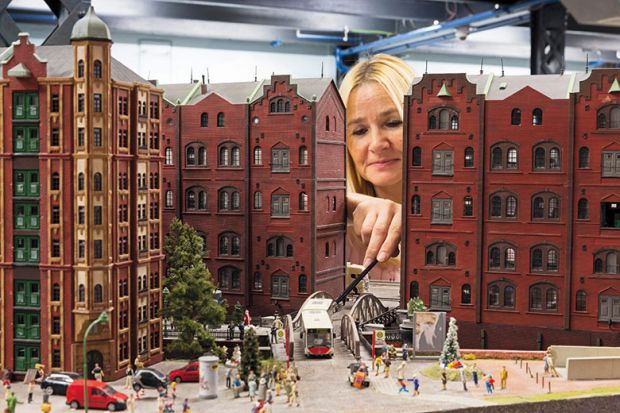Helen Sauntson was not actively looking to work at a small university. Her role as senior lecturer in English language and linguistics at York St John University, which has only 7,000 students and about 850 staff, was just “one of the jobs that came up which I liked the look of”, she recalls.
But her move from the University of Birmingham seven years ago has turned out to be a happy accident and Sauntson credits York St John’s petite size as one of the reasons for her current feeling of fulfilment; Birmingham has around 35,000 students and more than 8,000 staff.
Its smaller size means that York St John, which gained university status in 2006, “feels much less corporate” than Birmingham, says Sauntson, who is now a professor at the former Anglican teacher training college. “It feels more personalised. You get to know people in other departments and other schools. It feels like a community and that’s how everyone describes it.”
Students also benefit from the tight-knit feeling, she says. “They know they have a lot of support and they’re not going to get lost in the system because it is small and manageable.”
And while York St John, being far less likely to win the massive research grants that often flow into Russell Group institutions, is “much poorer” than Birmingham, Sauntson insists that the “benefits outweigh the challenges”, and she is actually more research-active in her current position.
Extensive research has been published on the impact of class size, particularly on how smaller tutorials lead to improved student outcomes. But studies focused on the overall size of universities and the effect this has on their performance, culture and operations are much more scarce – even though such questions are increasingly pertinent at a time when many universities and higher education systems across the world are expanding, and students and governments are demanding more from their institutions in terms of quality of services and impact.
Analysis of the latest Times Higher Education World University Rankings data shows that there is a relatively strong positive correlation between the number of research staff at an institution and its teaching reputation and research reputation (both 0.38, where a perfect positive correlation is 1 and a perfect negative correlation is -1). This increases to 0.57 and 0.61 respectively when only institutions in the top 200 of the ranking are analysed, and is even higher for UK and US institutions.
Meanwhile, universities in the top 200 with a high number of academic staff tend to receive a weaker score for international research collaboration (-0.42), suggesting that small institutions perhaps have more incentive to build ties with scholars from other countries. However, in the US, there is a strong positive correlation between the number of research staff and international collaboration (0.43).
The number of students at a university generally has little effect on their performance in this research-focused ranking. But in the student-focused THE Europe Teaching Rankings, universities with fewer students tend to receive higher scores for student interaction (-0.25 correlation), based on students’ responses to two survey questions on their interaction with their peers and teachers. This rises to a correlation of -0.53 in the Wall Street Journal/THE US College Rankings – although, interestingly, US students are more likely to recommend their institution if it has a large student body (0.23).

The California Institute of Technology is arguably the world’s most renowned small university. It has only 2,240 students and 349 academics, but counts more than 30 Nobel laureates among its alumni and is ranked second in this year's THE World University Rankings.
Thomas Rosenbaum, president of the institution, says that unlike many of its peers, “we actually don’t try to grow”; its faculty has increased by only one member of staff per year for the past 25 years. “We try to get better but not bigger,” he explains. "What that means is that we are constantly trying to identify areas where Caltech can be a world leader. We put big bets on those areas, we devote a lot of resources to them and given the constrained size then we’re constantly asking what do we do and what don’t we do.”
Rosenbaum says Caltech’s small size helps to facilitate interdisciplinary research and collaboration and eliminate administrative barriers. Graduate students can, he explains, “work in any laboratory, with anyone they want, without any bureaucratic obstacles”, while it is not unusual for academic staff to switch fields if they have the skills to solve a problem in another department or division. “Part of that is having flexible funds that allow people to get established in new fields and then develop enough of a track record that they can then generate external funding,” he says.
Rosenbaum admits that a lack of critical mass could be seen as a drawback of the Caltech model. “If you’re a faculty member and you want to talk to six or seven people who do exactly what you do, we’re not a good place,” he reflects. However, "the reason we don’t grow is because we really want to make sure that people talk to each other [across departments]. It’s a trade-off in the sense that with more people you can do more things. But there’s an intellectual rigour to thinking about what you want to do and there’s this intimacy and collaboration that grows out of being small.”
Dartmouth College in New Hampshire is another leading small research institution, with only 4,400 undergraduates, 2,100 graduate students and 3,200 staff. Philip Hanlon, president of the private Ivy League university, says that the US model of higher education includes two broad types of institution – small, liberal arts colleges that focus on undergraduate teaching, and larger research universities where “in many people’s telling, undergraduates get short shrift”.

Dartmouth, however, tries to follow a different strategy. It has small class sizes and close interaction between academics and students, as well as a strong research focus. “We’re asking our faculty to be not only outstanding researchers but also great educators and committed to undergraduates in particular,” he says.
One impact of having a low number of students and staff is that the campus itself can be small and there are few divisions between research specialisms, Hanlon says. Dartmouth’s engineering school, for instance, has no departments.
“I was at the University of Michigan before, which was the other extreme. It was geographically spread out but it was administratively spread out too,” Hanlon says. “There were so many students and so many faculty that there were sort of mini empires that were built up internally and it was hard to cross those boundaries.”
However, the notion that universities must be small to be elite and that they decline in quality if they grow is simply a “caricature in the popular mind”, according to Simon Marginson, professor of international higher education and director of the Centre for Global Higher Education at the University of Oxford. Most “superpower institutions” have grown, he notes. Oxford, the number one university in the latest THE World University Rankings, is a medium-sized institution, with 21,000 students and about 5,800 full-time academic and research staff. Harvard is a similar size.
In contrast, many of Australia’s prestigious Group of Eight are very large. Monash University is the biggest, with 53,000 full-time equivalent (FTE) students, according to data submitted to THE World University Rankings. UK universities tend to be smaller; the country’s biggest institution, apart from the Open University, is the University of Manchester, with 37,000 FTE students. But Marginson says that this is mainly because UK institutions have always been small and change is rarer within established systems. “The UK could manage larger universities if people had that in mind as the thing to do,” he says. He admits that Oxford would struggle to grow further, given its collegiate system, heritage buildings and the lack of space in the city. But, in the absence of these constraints, it could easily “expand by 50 per cent” and maintain its quality, he insists.
In many east Asian systems, Marginson notes, a combination of population growth, economic development and an increase in the number of high-quality applicants means that universities are getting bigger. Several leading universities have rapidly grown in a generation, he adds, citing the Hong Kong University of Science and Technology, which was founded in 1991 and has more than 10,000 students, as one example.
Taiwanese universities are also set to expand – but in response to a declining population. Taiwan’s Ministry of Education has promised additional funding for institutions that merge, as part of plans to downsize the island’s higher education sector. Earlier this year, three technology institutions in the country announced plans to consolidate in a bid to become a “top Asian university”. If the merger goes ahead, the new university would have about 32,000 students and 1,200 lecturers.
Michael McAleer, chair professor in economics at Asia University, Taiwan, says many universities in the country “will go bankrupt” if they do not amalgamate: “National Taiwan University is the biggest national university in Taiwan and it gets the bulk of government funding, so it’s safe. Every other university is under the gun as far as finance is concerned.”
McAleer co-published a paper earlier this year on the impact of university size on performance in THE’s research-focused rankings for institutions in Japan. The principal finding is that larger universities in Japan tend to be ranked higher, driven by their higher scores in research metrics. McAleer says he has generated similar results when repeating the study for universities in China, South Korea, Taiwan and India.
One reason for this, according to McAleer, is that larger universities tend to have medical schools, which produce a disproportionately high volume of research. Larger universities are also more likely to have a higher number of research-active scholars, he says.
“The larger the university, the more likely they are to have some people who are doing outstanding research in both quantity and quality…[and the more likely they are to be able to] carry those who are not performing. Smaller ones have to be very tight with their budgets and they have to be very careful. And if you’re only hiring people who are very good it’s going to cost you. Large universities can afford that more readily.”
But Marginson rejects the idea that there are greater research benefits for very large universities: “Once you are medium size and a fully fledged comprehensive university, if you greatly increase your research base it doesn’t increase your capacity to do more interdisciplinary work,” he says. “In terms of scientific firepower, it is the quantity of quality that counts.”
However, he says that there are economic advantages to expanding. Bigger institutions tend to benefit from “economies of scale” and larger networks of alumni, while growth in revenue and student numbers is essential for development because “it is very difficult to close moderately successful units in teaching. You might save staff costs but it often costs more to remove them than to keep them open…So when new things have to be done – due to changes in the environment or industry – universities add on rather than take away. So they need growth money.”
Marginson, however, concludes that “class size is more important than size” overall, adding that wealthy universities such as Oxford "are better placed in this regard”.
Several small liberal arts universities in the US, which are characterised by their focus on undergraduate teaching, mentorship and small class sizes, have run into financial difficulties recently. A 2018 report from financial services company Moody’s found that US private colleges are closing at a rate of about 11 per year and this rate is expected to increase in the future owing to falling tuition revenue and rising expenses.
Meanwhile, a report published the previous year by the American Council of Trustees and Alumni (Acta) revealed that small, private baccalaureate colleges in the US typically spend 64 cents on administration for every dollar spent on instruction. This drops to 27 cents on average for research-intensive doctoral universities.
Michael Poliakoff, president of Acta, says that the tendency for bigger class sizes at large universities is one reason for this discrepancy, but notes that there is also “an economy of scale that is very difficult for small colleges to realise”. However, he says that the “particular financial challenges” that small universities face can be overcome with “extra effort and a different kind of strategic vision”.
A small college “cannot try to pretend that it’s Harvard with an enormous multibillion-dollar endowment”, he says. “It has to prioritise its academic programmes and concentrate on what it can do well and what students most need.” In that regard, Poliakoff castigates the University of Tulsa, which has 5,000 students, for maintaining its elite athletics team while “cutting deeply into its liberal arts programmes”. In contrast, Sewanee: The University of the South in Tennessee gave up its membership of the Southeastern Conference athletics club in the 1940s after refusing to build a larger stadium, he says. “They can now boast that they have produced 26 Rhodes scholars. It’s very clear that they made an academic prioritisation and it really worked.”
Small institutions must also “embrace the formation of consortia with other small schools” and share academic and administrative resources to “do more with less”, Poliakoff adds. For example, the 15 members of the Associated Colleges of the South have a virtual department of Classics that enables them to deliver Greek, Latin and ancient history programmes at a lower cost.
Indeed, even larger universities are saving money by collaborating on less popular courses that would prove financially unsustainable for a single institution. The Shared Course Initiative is a collaboration between Columbia, Cornell and Yale universities to share instruction of “less commonly taught languages”, such as Khmer (the official language of Cambodia), Finnish and Twi (a dialect of the Akan language, mainly spoken in southern and central Ghana).
Poliakoff says that universities do not have to be small to deliver high-quality teaching, but the larger universities that tend to be more successful at it, such as the Ivy League institutions, are generally “very wealthy”. However, he suggests that some bigger universities could provide a strong student experience if they shifted their priorities: “Too often, what one sees at large institutions is the buying of star faculty who will be doing little teaching and typically only at the high level or in very large lecture classes. That’s quite a different experience from being a student with the opportunity to work with an experienced senior faculty member from a very early stage [and] to know that there’s a faculty member who deeply cares about his or her academic progress.”

In the UK, the abolition of student number controls, begun in 2012 and completed in 2016, has rapidly shifted the size of many institutions (a similar trend was seen in Australia during its demand-driven system between 2010 and 2017). A 2016 THE analysis of Ucas data found, for instance, that Aston University nearly doubled its recruitment of UK/European Union students in the four years to 2015.
London Metropolitan University, in contrast, saw the biggest fall in UK/EU acceptances, while the temporary loss of its visa sponsorship licence in 2012 also hit international recruitment. The institution now has just 9,200 students, compared with about 25,000 in 2010 – and a deficit of £20 million.
Lynn Dobbs, who became vice-chancellor and chief executive of London Met a year ago, does not see “any positives” around the drop in student numbers, but adds that the university has now “turned the corner” and is looking to “systematically grow” by just under 10 per cent over six years. “I believe that there’s an optimum size for a university and we need to be slightly larger to ensure that we can deliver our programmes efficiently and effectively,” she says. “The minimum size we’d like to be is 10,000 students. We’re certainly not heading back to 25,000.”
She still supports the idea of an uncapped overall system because it facilitates the use of higher education to address inequality. “But some control at institutional level is something that should be considered,” she adds.
Another institution that is committed to access is KU Leuven in Belgium. Like all universities in Flanders, it is required to have an open admissions system; as a result, it has 58,000 students and is the second largest private employer in Belgium, with 22,000 employees including University Hospitals Leuven. But those students are spread across 14 different campuses of varying sizes across 10 Belgian cities.
“I don’t think that students on a given campus have the feeling that they are part of a huge institution, because if you have 14 campuses then the scale is spread across so many different locations,” says the institution’s rector, Luc Sels. Moreover, he is “proud” that KU Leuven, which is ranked joint 45th in the latest THE World University Rankings, is “one of the very few highly ranked universities with an open admissions policy”.
“We call our model ‘excellence by inclusion’. The fact that so many people can receive a very high-quality education in a leading university like KU Leuven creates a societal impact which is, in my opinion, much higher than in many universities with a closed admissions policy,” he says. “If you take into account that the eight Ivy League universities have not even together 60,000 undergraduate students...then you immediately see the huge difference in the share of the population that you reach with your scientific work.”
And while the new Flemish government, which was elected last month, is debating whether to introduce selective admissions for more expensive subjects in a bid to improve success rates, Sels says he does not expect big changes.
Across the border in France, a series of university mergers has resulted in many small and specialist institutions becoming part of larger universities in a bid to become more visible globally. It is the reversal of a move that split several universities into smaller parts in the 1970s.
Meanwhile, new groups of universities, originally known as ComUE, have also formed. One example is Paris Sciences et Lettres – PSL Research University Paris, which was established in 2010 and has 11 academic member institutions. Despite its many parts, Hubert Bost, vice-president for research and graduate education at PSL, describes the combined institution, with its 17,000 students, as “medium-sized”, while its student-to-academic ratio of 10:1 allows it to “keep a close relationship between students and staff”.
Emmanuel Basset, director of research and graduate education at PSL, adds that the merger enables the institution to “do things that our component schools alone wouldn’t be able to achieve”. On the research side, PSL has more funding to back “exploratory”, “risky” and interdisciplinary research programmes that would be unlikely to receive income from funding agencies, he says. It is a similar story on the education side, with the creation of new postgraduate programmes in innovative areas. A master’s in Earth sciences, for instance, “gathers expertise from four institutions of PSL”, Basset says.
New joint academic positions across several PSL member institutions have also enabled the university to “attract top researchers” who would have been unlikely to work at one of the smaller component institutions, Basset adds. “These researchers know that now in PSL in their field there is a larger community that they can interact with,” he says.
The University of South Australia (UniSA) was established as a result of the 1981 merger between the South Australian Institute of Technology and the South Australian College of Advanced Education. Last year, it also considered merging with the University of Adelaide, before the plan was abandoned. This would have created an institution of more than 50,000 students.
David Lloyd, vice-chancellor and president of UniSA, which has 33,500 students in its own right, says that scale can provide universities with “a fairly predictable revenue base”, enabling it to “buffer fiscal changes in a way that smaller institutions can’t”. But while Adelaide and UniSA had “complementary research offerings”, Lloyd says that duplication on the teaching side would have been a major challenge. “The rationale for concluding the dialogue [was that] when we looked through the cost-benefit base, the costs would have been excessive,” he says.
Back in the US, Dartmouth’s Hanlon does not rule out the institution’s growing in the future as long as such an expansion does not disrupt the “close connection between faculty and students” resulting from its low (7:1) student-to-faculty ratio. However, he notes that an increase in size could enable the university to “offer a fantastic educational experience” to more students.
“That’s kind of the trade-off,” he admits. “We understand that what we offer is incredibly valuable and the more we can do it, the more we can have a positive impact in the world. [But] we don’t want to denigrate what’s very special by that growth.”
POSTSCRIPT:
Print headline: Is small still beautiful?
Register to continue
Why register?
- Registration is free and only takes a moment
- Once registered, you can read 3 articles a month
- Sign up for our newsletter
Subscribe
Or subscribe for unlimited access to:
- Unlimited access to news, views, insights & reviews
- Digital editions
- Digital access to THE’s university and college rankings analysis
Already registered or a current subscriber?








